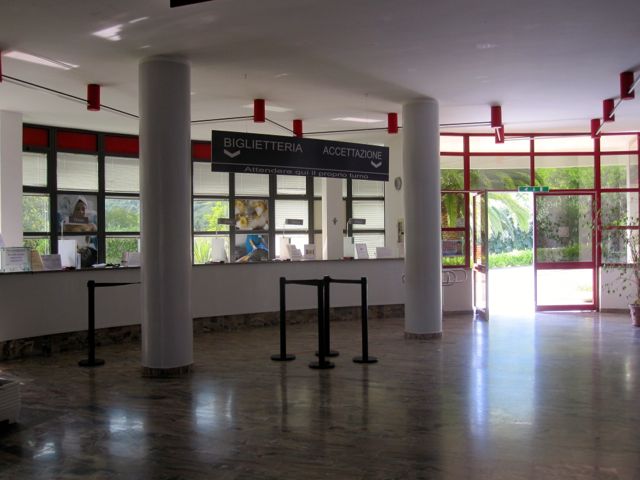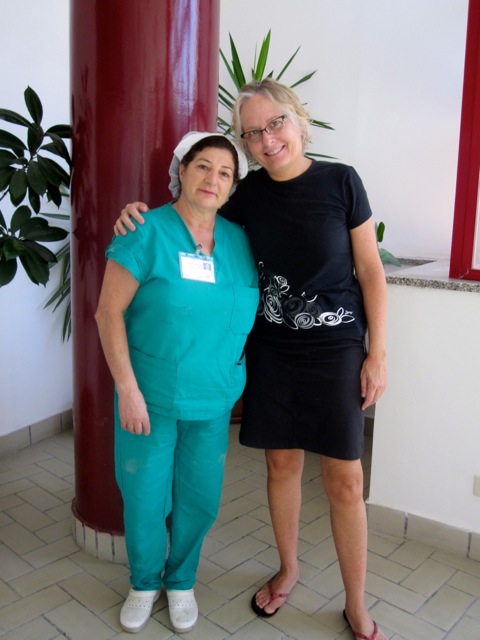THE “CURE” IN LAMEZIA TERME
Using her hand like a shovel, Maria scooped up a goodly portion of mud and unceremoniously thwocked it onto my elbows, diving back into the gooey substance for my wrists, my feet and knees. Then, with multiple plops of the thick, grayish mud onto the table’s raised backrest, she instructed me to lie back onto the numerous piles of the hot, sticky matter. I was in room 36 of the Terme Caronte or the Caronte Spa, located in Lamezia Terme, a Calabrian town whose name reflects the presence of the curative properties of its water and mud.
Several years earlier I had taken a “cure” for my nasal passages at the Terme Luigiane further up Calabria’s Tyrrhenian coastline near Guardia Piemontese and recounted the experience in my book Calabria: The Other Italy. Since then, I’ve visited Calabria often, but this was my first opportunity to visit the spa in Lamezia Terme.

Terme Caronte in Lamezia Terme, Calabria
I might have been tempted to just sign up for a few traditional beauty treatments at the adjacent Centro Idroestetico (Center for Hydro-aesthetics) where you simply paid for your chosen services, but it was closed for restructuring. The Terme Caronte, however, was a certified healthcare facility for rheumatic, ear-nose-and-throat, gynecological and respiratory treatments, so it required an on-site doctor’s visit as well as a prescription from one’s primary care physician in order for the services to be covered by the Italian national healthcare system. Thus, no facial or detoxifying body mask for me on that particular visit to Lamezia Terme.

Check-in at Terme Caronte
THE MUD AT TERME CARONTE

Mud ready for application at Terme Caronte
The mud was warm, 52 degrees Celsius, I was told. That would be about 126 Fahrenheit. My hands and feet were pinned under its weight. The consistency was like an extremely heavy dough. I was reminded of Play-Doh as I sunk my fingers into its mass. Unlike the mud treatments that are painted or smoothed onto the body in a beauty spa, this thick, hot, weighty mud focused on the joints and points of articulation. My feet hadn’t felt so good in years.

Mud table at Terme Caronte
After the mud was distributed, I was wrapped in the gauze and plastic sheet set up on the table to keep me warm in my sulfurous cocoon. It was a comforting warmth despite the clinical atmosphere. The sulfur smell was very present, but not stinging to the nostrils. I didn’t have to suffer from rheumatism to benefit from its healing properties.
At a certain point, Maria came back in to wipe my brow, and after about ten minutes assisted me in removing the bulk of the mud before rinsing it off completely in the adjacent shower stall. The one size-fits-no one, throwaway paper underpants immediately ballooned out with greenish gray, muddy water. It was time to throw them away before the hot bath.

Tub and shower at Terme Caronte
THE SPA’S OZONE BATH
Maria had the thermal water prepared in the large plastic tub. I climbed in and pushed the button for the action to begin. The whirlpool was similar the day before, but without the added benefit of ozone. The doctor had recommended fango con bagno gorgoliato e ozono (mud with bubbling bath and ozone), but on the previous day there wasn’t an appointment available for a bath with ozone, a gas that supposedly enhances the curative properties of the water, removing skin impurities and aiding blood circulation. I couldn’t help but noticing there was only a 1-Euro difference and wondered why all the baths wouldn’t include ozone. “No, thank you. For the extra Euro, I prefer to keep my impurities and poor circulation.”
Apart from the ozone, all the water in the various baths was the same, whether there was a hydro-massage or gurgling action involved. The sulfurous liquid was a comfortable 38 C or 100 F, and the movement of the water was quite pleasant. My skin felt even better the second day, but I wasn’t able to judge if it was a cumulative effect or the ozone working its magic. I can only imagine how good my skin would have felt and how my blood would have been zipping through my veins if I had come anywhere near the spa’s recommended program of twelve treatments. Maybe next time, but as suggested by Maria, my fanghina, I dipped my whole head under the bubbling liquid in order to gain maximum benefit from my two visits.
FANGHINA, FANGHINO??

Author with Fanghina Maria Carmela Paula
The fango (mud) is applied by a fanghina (fan-GI-na), when the healthcare worker is a woman, or fanghino, for a man. The job title sounds much better in Italian than in English, where you’d either have to go for a straightforward, “mud lady” or a longwinded, “mud therapy technician.” In any case, I experienced very affable healthcare workers at the spa, from the young woman who streamlined the process for me at the front desk and enthusiastically waved from her car as I saw her drive away at the end of the following day, to the female doctor, to the man who took care of the buckets of mud, to the fanghini.
My fanghina happened to have relatives in Patterson, New Jersey, and was pleased to hear that I had grown up nearby. She wanted to know my impressions of Italy and she told me how she was emotionally moved when she saw New York City for the first time. The Big Apple was an iconic place for her, but after the initial impact wore off a bit, she was surprised to see some of the negative aspects. NYC looms large for many Italians.
LAMEZIA TERME

Terme Caronte
If you haven’t ever been to Calabria, you might never have heard of Lamezia Terme, and thus you wouldn’t know that it boasts an international airport with passenger flights to Europe and Canada. If just passing through, there’s also a free, open-air natural hot spring pool just across the street from the Terme Caronte. It’s quite basic, although there’s a little cubicle of a changing room in which to remove that slightly odiferous bathing suit after submerging in the shallow sulfurous water, which isn’t quite the same as in the spa across the street, where I noticed they were in the process of building an outdoor pool as well.

Free outdoor pool in Lamezia Terme
I’d also recommend stopping in at the Hotel-Ristorante La Mimosa just up the street, or look at this plate of tagliatelle with porcini mushrooms from the Sila Mountains and decide for yourself.

Tagliatelle ai porcini, Hotel-Ristorante La Mimosa
As instructed by the check-in doctor, I didn’t shower again until the next day, letting the therapeutic properties of the water continue to do their work. The low-level sulfur smell on the skin didn’t interfere at all with the delicious mushrooms. And oddly enough, I felt cleaner than on the previous day. The ozone must have done its job – well worth it for the extra Euro!
 Read about my visit to another spa in Calabria, the Terme Luigiane, in Chapter 16 of Calabria: The Other Italy or get a glimpse of the experience on my blog post, Painted Stories of Calabria.
Read about my visit to another spa in Calabria, the Terme Luigiane, in Chapter 16 of Calabria: The Other Italy or get a glimpse of the experience on my blog post, Painted Stories of Calabria.
Would you like to read more about mushrooms in Italy? Go to my blog posts about the Mushroom Festival in Mammola and eating Mushrooms in Calabria.
Sign up below to receive the next blog post directly to your email.
More information on the spa (in Italian) can be found on the Terme Caronte website.

Comments 10
Sounds simply divine, Karen. Have you noticed a long lasting effect in your joints?
Author
It hasn’t even been a week yet. In the month prior I had done a ton of walking, up and down hills, and I arrived exhausted. I must say, though, that I felt better immediately, but I only did 2 applications. The recommended “cure” length is 12 days.
Every bit of it looks very inviting!
Author
It was!!
I could use a treatment right now! The mud bath brings back memories of our time together in San Francisco : )
Author
Ha, ha – I had forgotten about our Calistoga “spa” experience! This mud was smoother, there weren’t any little sticks digging into body parts, and no overwhelming odor! I think you’d like it.
Do they have a hotel with the mud therapy and spa that one stay and have the treatment as they have in many Italian as In Abano Terme ?
Author
The Terme Caronte doesn’t have a hotel attached to the property. The 2-star Hotel-Ristorante Mimosa is the closest at 300 meters. The “THotel” in Lamezia has a centro benessere or wellness center with massages, hot-stones and a spa area, but not the mud or inhalation therapy. The Terme Caronte also has beauty treatments. Other terme in Calabria do have hotels, such as the Terme Luigiane in Acquappesa, further north near Guardia Piemontese. There’s a chapter in my book about my experience there and some information on this blogpost: Painted Stories of Calabria.
Hello
Liked reading your blog on the thermal spas in Calabria.
Particularly Terme Caronte and the mud treatments.
Author
Glad you enjoyed the post. So many people fly into Lamezia Terme and hurry on their way to other locales. I stopped to smell the sulfur, as I do like a good mud treatment.